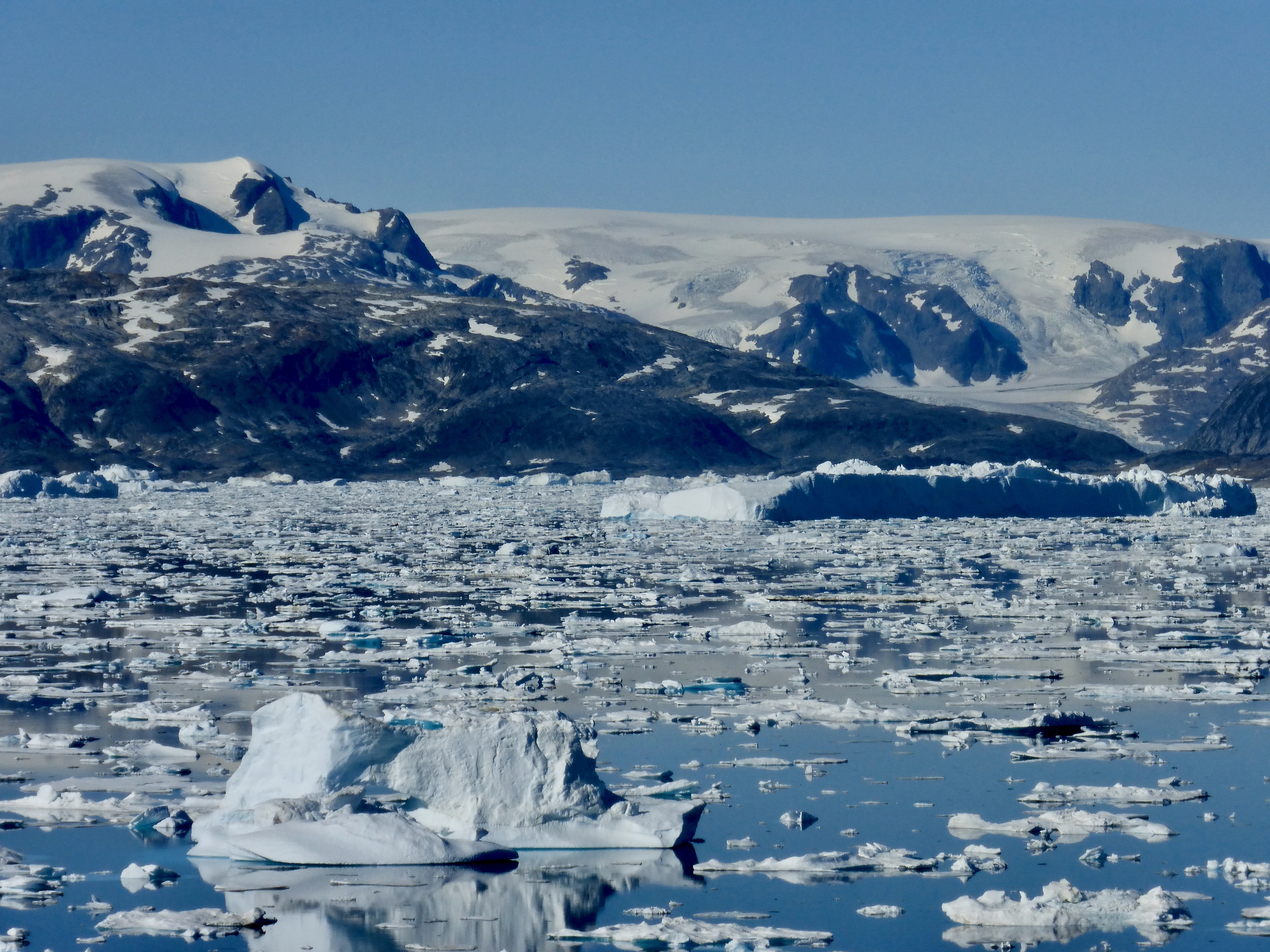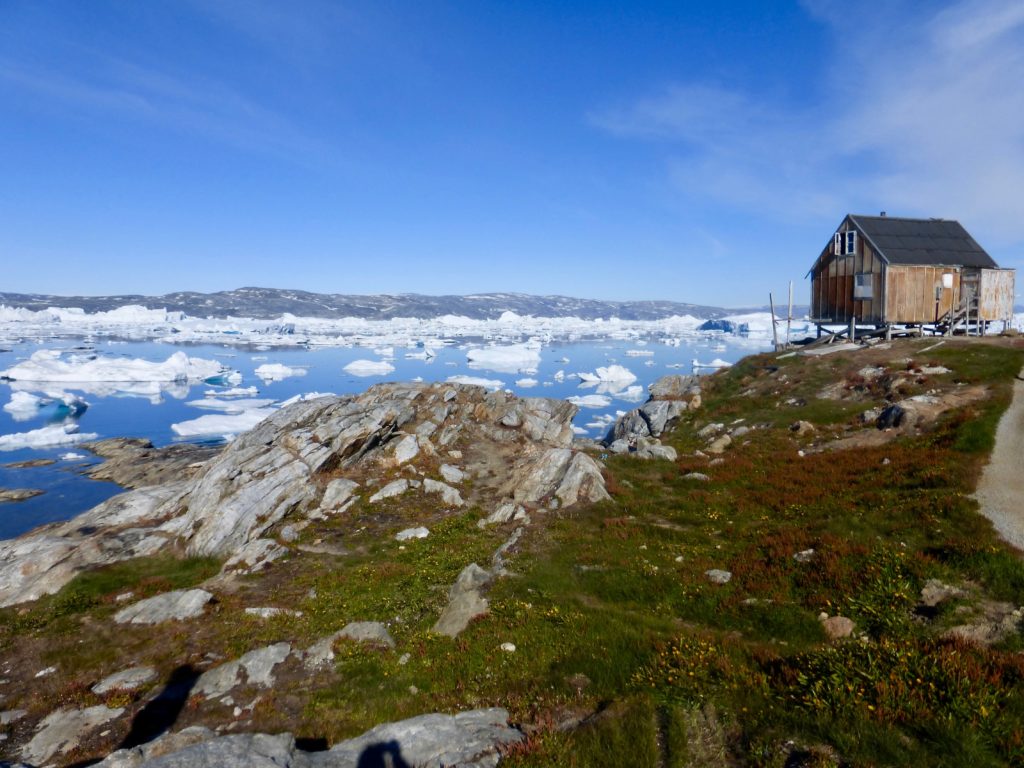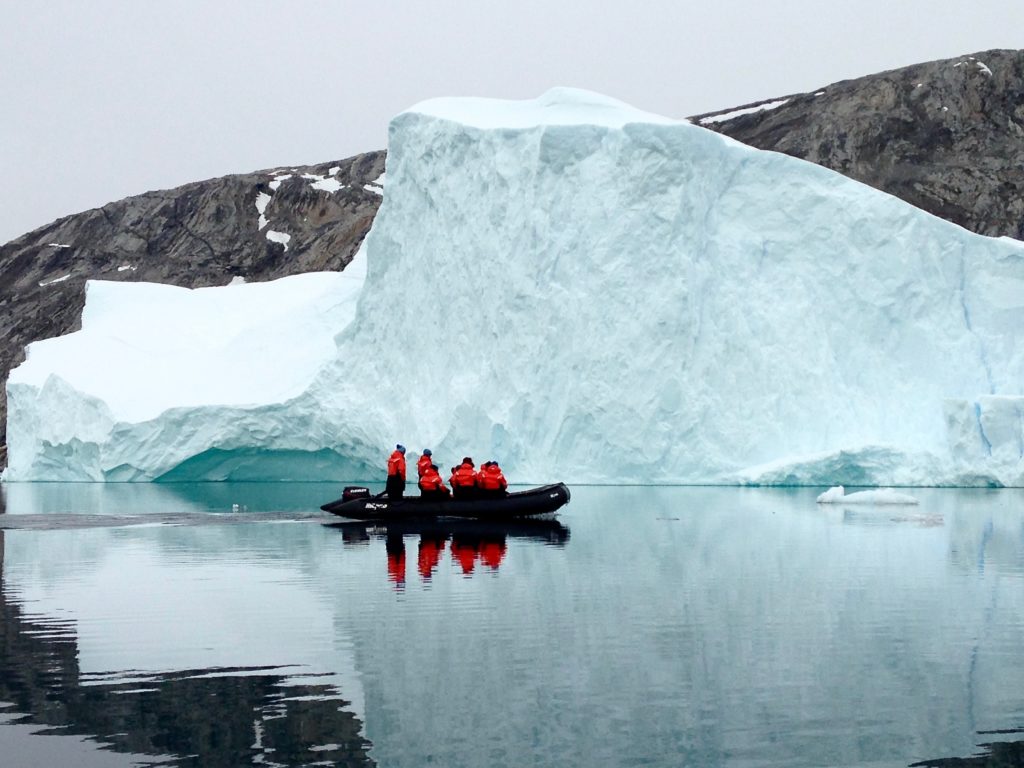
21 Oct Julius Nielsen: Bridging Old Ways and New Paths in East Greenland
Julius Nielsen may have a Danish name, but he’s East Greenlandic Inuit through and through. And that status makes him an invaluable member of the team at Base Camp Greenland, a deluxe expedition camp built by Natural Habitat Adventures in 2015 to take guests to one of the most remote and pristine places on the planet.
Unlike most Greenland tourism that focuses on the territory’s more populated west coast, Base Camp Greenland offers an immersion in wilderness and solitude—both in epic proportions. The isolated outpost, at the mouth of a broad glacial valley fronting a protected bay, is set up seasonally each summer on Ammassalik Island, just below the Arctic Circle.
During the season at Base Camp, which runs from mid-July to mid-September, Julius takes guests on Zodiac tours in Sermilik Fjord, weaving among a crush of icebergs that calve off the glaciers that pour from the Greenland ice sheet to feed the inlet. Now in his late 30s, he grew up on the ice and knows its movements as intimately as anyone can.
The consummate local guide, Julius’ deep connection with the Ammassalik region, its daunting mountains and icy maze of fjords helps keep guests safe as well as enlightened during their stay at Base Camp.
Two Feet in Two Worlds
Julius moved to the tiny village of Tinit (Tiniteqilaaq) across the bay from the camp when he was 4 years old. He spent a decade of his childhood there before heading off to the “big town” of Tasiilaq, 25 miles away as the crow flies, for high school at 14. Though the distance between the towns is not far, getting between the two still requires either a dog sled journey across a mountain range in winter or a 4-hour boat ride once the ice melts in summer—and even then, drifting bergs can close channels with little notice. Today, Tasiilaq has about 3,000 residents and is the administrative center and largest community in East Greenland. Tinit is home to fewer than 100.
When he was a teen, Julius also spent a year in Copenhagen to learn Danish. Though his stint in the modern Scandinavian capital made him feel as though he had landed on another planet, he was facile with the language. Eventually, he also taught himself English by watching subtitled movies and using Google Translate. His fluency in both languages would later prove essential to his part-time career as a guide.
Though Julius trained as an electrician and worked in Greenland’s capital of Nuuk for four years, ultimately the city of 20,000 felt too crowded, with traffic and stress causing “the heart to beat too hard,” as he told our group on a recent visit.
“That’s not our life,” he explained, relating how he and his wife chose to return to Tasiilaq. Though they are no longer together, they are happy to be raising their four children with both wilderness and family nearby. His mother-in-law lives in Tinit, and guests from Base Camp are invited for a visit to her home on each trip. When our group arrived, she gathered us in the living room for tea, proudly showing off her many photos of her grandchildren. She also modeled the intricately sewn and beaded traditional costumes of East Greenland that she creates, which today are worn for festive occasions and special celebrations.
An Ancient Lifestyle is Disappearing
In Tasiilaq, Julius and his family are surrounded by vast, wild landscapes where he can practice the subsistence lifestyle he so loves, running his dog team and hunting for seal and narwhal that still comprise dietary staples for East Greenlandic people. It’s a pursuit that’s dying, however, as modern-day Greenlanders are forced to survive in a world in which both culture and climate are changing faster than they can adapt. Their plight is charted in a documentary called The Last Ice Hunters, in which Julius has a role; the film will be released in 2018.
The younger generation coming of age now, including Julius’ children, are not likely to continue the hunting traditions that were integral to their grandparents’ lifestyle and that formed the bedrock of Inuit culture for millennia. Though Julius’ family and many other East Greenlanders subsist extensively on seal meat, fewer kids are learning to hunt with their fathers, pulled instead by the draw of indoor screen-time just as much as their counterparts in warmer urban climes.
Julius laments that Greenlandic kids have become soft, incapable of the physical rigor, inner drive and tenacity it takes to become a hunter. While one of his sons shows an affinity for learning to hunt alongside his father—a fact that Julius takes pride in—the other has no interest whatsoever and hopes instead to leave Tasiilaq to discover the wider world beyond.
Selling the pelts of seals hunted for meat was formerly an important dimension of East Greenlanders’ local economy, but widespread opposition elsewhere to the broad commercial seal trade put an end to this opportunity for the Inuit. Regulations banning the import of seal pelts into the U.S. (since 1972, under the Marine Mammal Protection Act) and the European Union (since 2009, though with certain exceptions for Inuit products) have largely removed the market. Some East Greenlanders still fashion the pelts into extremely warm winter clothing for frigid outdoor pursuits, however.
With the demise of the seal hunt all but accomplished, the base for the socio-economy, culture and identity of the Inuit becomes tenuous, and a younger generation is having to reinvent itself when it comes to creating a livelihood. Julius is at the vanguard of that effort.
Adventure Tourism Offers New Opportunities
While he was never fond of being the electrician he trained to become, Julius has found another way to help support his family while remaining in the place that’s at the very core of his being. His language facility and outgoing personality have earned him the opportunity to become a tourism entrepreneur in his native region.
In addition to serving as a guide and translator for many international film crews, he started with offering dog sled trips for hardy tourists in winter and early spring. It’s a rare chance for visitors to head out across huge tracts of wilderness for several days at a time behind a team of Greenlandic sled dogs, the only breed of dog allowed on the entire island, to protect historic bloodlines. Julius’ guests get a truly authentic experience of this ancient Inuit practice as they help drive the team, staying in rustic wooden hunters’ huts. He arranges custom journeys for all sorts of adventures, including dog-supported cross-country ski trips.
As the Arctic warms, however, each year it gets trickier to predict the patterns of the ice, Julius said. It used to be possible to cross Sermilik Fjord reliably for a given span of months, and traveling between villages by dog sled was the most common mode of winter transportation for local people. Now, it’s tough to know when the broad fjord will freeze solid or how soon it will break up, creating a mosaic of unstable puzzle pieces. Julius still prefers to rely on his dogs, however, as they are able to adapt to shifting conditions. Dogs can sense weakness in the ice and go around a thin place, he explained, whereas a snowmobile will simply fall through the slush.
Exploring from Base Camp Greenland
In 2015, Julius signed on with Natural Habitat Adventures as a local guide for the company’s Base Camp Greenland program. He accompanies each group, along with an NHA Expedition Leader, on in-depth explorations in the Sermilik Fjord region. Excursions include all-day Zodiac “iceberg cruises,” with guests bundled up in Arctic survival suits that can be stripped off for hikes ashore.
A highlight, ice conditions permitting, is a journey into Johan Petersen Fjord for a close-up view of the edge of the Greenland ice sheet. This fjord, an arm of mighty Sermilik Fjord, is part of this “living laboratory” where visitors can directly witness the effects of planetary warming. The sheer amount of ice breaking off the rapidly melting glaciers is stunning. And it’s clear, when you’re navigating among drifting bergs bigger than buildings, that a guide with local knowledge like Julius’ is imperative.
Julius says his passion is “sharing Greenland’s incredible nature” with visitors. “And I hope they know a little bit of the culture, too,” he adds—an inevitable outcome when you spend a day in a Zodiac with Julius guiding you through the ice and regaling you with stories.
# # #
Natural Habitat Adventures offers 9-day tours to Base Camp Greenland from $10,995. 2018 trip dates begin July 20 and conclude with the Sept. 5 departure. The Discover Greenland adventure starts and ends in Reykjavik, Iceland.
Photos courtesy of Wendy Redal and Natural Habitat Adventures.
Latest posts by Wendy Redal (see all)
- 5 Books to Inspire Your 2018 Travel Adventures - December 20, 2017
- Looking for Lemurs in Madagascar - December 2, 2017
- Julius Nielsen: Bridging Old Ways and New Paths in East Greenland - October 21, 2017










No Comments